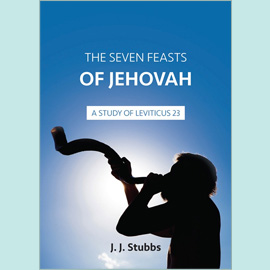There are twenty references in the New Testament to the Lord Jesus Christ being at the right hand of God. Six of these are used by the Lord Himself, three of which are quoted from Psalm 110.1 (Mt 22.44; Mk 12.36; Lk 20.42), and three referring to Him as the Son of Man sitting on the right hand of power (Mt 26.64; Mk 14.62; Lk 22.69). The other 14 references are noted under twelve headings.
The Perfect Servant (Mk 16.19)
Most believers appreciate that Mark presents the Lord Jesus Christ as the Perfect Servant, and so it is in Mark that we read of His unceasing and unhesitating energy in service for His God (1.35; 3.20-21). We see the Lord characterised by diligence in service, perfection marking all that He did, so that Mark alone records: "He hath done all things well" (7.37). In Matthew we have the authority of His word; in Luke the approval of His walk; in John the appreciation of His worth (His person); but in Mark we have the acknowledgement of His work. It is, therefore, not without significance that at the close of the Gospel of Mark the Perfect Servant is seen seated at the right hand of God (16.19), indicating that all that had been committed to Him while in this scene had been accomplished to God’s complete satisfaction. The final verse from Mark’s pen presents the Lord still working (16.20), introducing the continuation of His work.
The practical application is that we, as servants of God (1 Cor 7.22; 1 Pet 2.16), will only receive the approval of God if we are faithful and diligent in our service (1 Cor 4.2; 2 Tim 2.15). Such diligence in service should characterise each believer but, sad to say, many would rather expend energy on material things than devote time to the things of God.
The Proof of Lordship (Acts 2.33-34)
In this very important chapter we notice the descent of the Spirit of God (vv.1-13), the declaration of Peter (vv.14-40), and the details of those who believed (vv.41-47). In Peter’s address there is first the explanation of what had taken place (vv.14-21), then the exposition in relation to Christ (vv.22-36), and finally the exhortation to repent (vv.37-40). In his exposition the apostle speaks of the life of Jesus of Nazareth which brought blessing to the people and which was approved of God (v.22); of the death of Christ (v.23); of the resurrection of Christ (vv.24-32), using the words of Psalm 16 and Psalm 132. Finally (vv.33-36), before his exhortation, the apostle gives the proof of the Lordship of Christ. It is in these closing verses that Peter states that the crucified One is not only raised from among the dead but is seated at the right hand of God, and quotes Psalm 110 to substantiate this fact. Thus the proof of the Lordship of Christ is that He is now seated at the right hand of God. His Lordship is yet to be owned universally (Phil 2.9-11), but it is the believer’s privilege as well as responsibility to own this now by life as well as by lip. It is not enough to say, "He is Lord". We must prove what we say by our lives. The child of God who refuses to obey the Word of God has no moral right to call Him "Lord". "Why call ye me, Lord, Lord, and do not the things which I say?" (Lk 6.46).
The Present Sustainer (Acts 7.55-56)
It has been well said that in this passage we see the Lord standing to welcome Stephen, the first martyr of the Church, into glory. What a comfort it must have been to Stephen to have a sight of the Lord standing at the right hand of God. We note the difference between v.55 and v.56. In v.56 Stephen uses the title "the Son of man" to bring home conviction to those who opposed him, but in v.55 the name "Jesus" is used indicating the One who was despised and treated shamefully. Surely, as Stephen saw the Lord Jesus Christ standing at the right hand of God he was reminded that the Lord had been that way before him, and was sustained and comforted. All the scorn and ridicule, all the shameful treatment he was experiencing, all the pain he was about to feel, yea and more, had been experienced by the risen Lord. He who is at the right hand of God is able to sustain every believer in every circumstance of life. Our blessed Lord knows every situation, sees every tear, feels every pain, understands every heartache, for He is "touched with the feeling of our infirmities" (Heb 4.15), and "he is able able to succour them that are tempted" (Heb 2.18).
His ear is ever open to our cry and His heart is ever filled with love toward us. Many times we cannot go to our fellow believers for they may misunderstand - He never does; they may do nothing to help - He always does; they may say they have no time to listen - He always has; they may be cold hearted - He never is.
The Perpetual Intercessor (Rom 8.34)
We notice two intercessors in this chapter - the Holy Spirit makes intercession (v.26), while in this verse Christ makes intercession for us. In keeping with the character of the epistle we are again introduced to a court scene in vv.31-39 where questions are asked and answered. In v.34 the question is that of judicial condemnation. The apostle gives four reasons why the condemnation of believers is impossible.
(i) "It is Christ that died" - the death of Christ forbids forever the condemnation of those who are His. At Calvary Christ met fully and finally all the claims of the Throne of God so that "There is therefore now no condemnation to them which are in Christ Jesus" (Rom 8.1).
(ii) "Yea rather, that is risen again" - the resurrection of Christ is the proof of His finished work (Rom 4.25; 1 Cor 15.17). The fact that Christ is risen shows that the condemnation of believers is impossible.
(iii) "Who is even at the right hand of God" - the One who hung upon the cross in ignominy and shame is He who is seated at the right hand of God showing that the work He accomplished at Calvary needs no repetition.
(iv) "Who also maketh intercession for us" - His presence at the right hand of God is here linked with His priestly work of intercession. An intercessor is one who represents another, thus the risen Lord is the representative of His own, and is actively engaged in pleading their cause. This intercession is not intermittent but continual, while His people toil in the tempest of life (a beautiful picture is provided in Matthew 14.23-24). What an encouragement to know there is One at the right hand of God undertaking for us. This surely is a guarantee that one day we shall be where He is.
To be continued.









